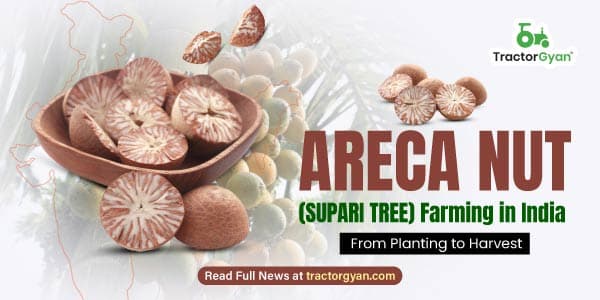Areca Nut (Supari Tree) Farming in India: From Planting to Harvest
Table of Content
Areca nut (Areca catechu) or supari is an important commercial plantation crop in India. It’s the prominent source of chewing nut, beetle or supari, which has a huge local and global demand. India is the world’s biggest producer and consumer of supari in the world.
Considering this, areca nut (supari tree) farming can be a smart venture for Indian farmers. In this Areca nut guide, we’re going to tell you everything related to areca nut farming techniques, ideal Areca nut farming temperature, and supari tree farming tips.
Introduction to Areca Nut (Supari Tree) Farming
Areca nut (Areca catechu) farming is a significant agricultural practice in India, particularly in states like Karnataka, Kerala, Assam, West Bengal, and Meghalaya.
Around 50 % of the world’s total agricultural production happens in these Indian states. Karnataka is the largest producer of supari trees in India, followed by Kerela and Assam. In Karnataka, around 2.15 lakh hectares are under areca nut cultivation.
The average size of areca nut (betel nut) gardens varies across regions. In Shivamogga district of Karnataka, the average size was 3.00 acres in Sagar, 2.00 acres in Thirthahalli and 4.00 acres in Shivamogga taluk.
Supari tree farming (Areca catechu farming) involves various stages from seed selection and sowing to planting, care, and maintenance.
Areca nut (Areca catechu) Varieties in India

Being the world’s largest consumer and producer of Areca nut (betel nut), India has developed several high-yielding areca nut cultivars and hybrids. Some of the notable areca nut varieties include:
-
Mangala (VTL-3)- Amongst the Areca nut varieties in India, this is best known for its higher nut set and quicker stabilization of production. The average Areca nut field for this variety is 2.90 kg chali/palm/year.
-
Sumangala (VTL-11)- This is the highest-yielding Areca nut variety and is suitable for both tender and ripe nut processing.
-
Sreemangala (VTL-17)- This is also a high-yielding Areca nut variety, cultivated in Indian states like Karnataka and Kerala.
-
Swarnamangala- This is a tall palm tree variety of Areca nut (betel nut). The nuts are bigger and heavier than usual. Mohitnagar (VTL-60)- This variety was released for commercial purposes only in 1991 and is best known for its uniformity. The tree bunches are well placed and the yield is constantly high. It’s mostly cultivated in West Bengal, Karnataka, and Kerala.
-
Kahikuchi Tall- This supari tree variety produces orange-coloured round nuts and comes to bear nuts by 5th year only. This variety was released in 2009 and is cultivated in Assam and Meghalaya.
-
VTLAH 1- This is a dwarf supari betel nut tree (Areca catechu) variety, producing yellow-orange coloured nuts and cultivated in Karnataka.
Areca Nut Farming: Steps and Best Practices
Areca nut farming (Areca catechu), like any other farming, requires strategic planning, and following a standard plantation process. Here is a quick overview of starting Areca nut (Areca catechu) cultivation in India.
Land Preparation
Farmers should plough and till the land properly to get rid of any remains of past crops, aerate the soil, and break down the soil lumps.
Raising of Seedlings
The Areca nut (Areca catechu) tree is propagated using areca nut seeds. Farmers have to go through four steps to propagate supari trees. These four steps are mentioned below.
-
Selecting the mother palm
The mother palm for the Areca nut (Areca catechu) tree has to be early and have a regular bearing, should have more leaves in the crown, a high fruit set, and shorter internodes. Such high-quality mother palm leads to high-grade germination.
-
Seed nut selection
For proper Areca nut farming, farmers should only select fully ripped nuts, weighing more than 35 grams. In addition, performing a float test is important. Farmers should take the nut and put it in the water. It should float vertically and its calyx-end should be pointed upwards.
-
Ideal primary and secondary nursery conditions
Areca nut seed must germinate properly to turn into an Areca nut (Areca catechu) tree. Farmers should sow the nut soon after the harvest in the sand or soil, ensuring adequate watering two times a day.
For proper germination, ensure that:
-
Betel Nuts are sown at a distance of 15 cm from each other
-
Betel Nuts are sown in a vertical position with calyx end covering.
-
The seedbed should be mulched using Areca leaves of paddy straw.
This is the primary nursery for Areca nut seeds, where they spend nearly six months.
After that Areca nut seeds need to be planted in secondary nurseries. The secondary nursery beds need to be 150cm in width, 15 cm in height, and feasible in length. You can also use polythene bags as a secondary nursery for Areca nut seeds.
In secondary nursery beds, Areca nut seeds should be planted at a distance of 30 cm from each other. In the secondary nursery, Areca nut seeds spend 12-18 months.
-
Seedlings selection for main fields
Twelve to eighteen-month-old Areca nut seeds are ready to be planted in the main field. Seedlings having five or above leaves and ideal girth are ideal for the main field. The pit on the mainland should be around 90cmx90cmx90cm in dimension to accommodate dwarf seedlings. These seedlings should have enough shade during the harsh summers.
Ideal Areca Nut Mainfield Sites
For proper growth, Areca nut seeds should be planted in ideal sites having features such as:
-
Humid areas have enough shade to avoid direct sun and heavy wind.
-
Proper water drainage is to avoid water logging as supari tree plants can withstand very humid environments.
-
Soil depth of minimum two meters and sufficiently low water table to support better root development.
-
In areas with higher water tables, farmers should adopt shallow betel nut planting techniques and plant seedlings at a depth of 90cm depth.
Areca nut Tree Care and Maintenance
Maintaining an Areca nut (Betel Nuts) tree is crucial for proper growth. There are many Areca nut tree care and maintenance tips that farmers should keep in mind.
-
Irrigation: Farmers should irrigate Areca nut (betel nut) plants once a week from November to February. These are the cold months in India and not much moisture is required. During March-May, farmers should irrigate supari tree crops once a week. The flood irrigation requirement is 175 lit/ tree/ day while the drip irrigation requirement is 16 – 20 lit/ tree/ day.
-
Manuring: Every bearing Arecanut palm, aged above 5 years, should be manured using 10-15 kg of FYM or green leaves and 100:40:140 g of NPK/ tree/ year. The manure requirement of Areca nut (Betel Nuts) trees less than five years old is half of what we’ve just mentioned above. The ideal time to add manure to the Areca nut crop is during January - February post-North-East monsoon and an ideal place to add the manure is at the basin of 0.75-1.00 m radius and a depth of 20 - 30 cm. Lime is also applied at 1 kg/tree/year.
-
Weeding: Farmers should also do weeding twice or thrice in a year using a spade.
-
Intercropping: Intercropping is often recommended to provide enough shade to the Areca nut trees. Farmers can cultivate cocoa, black pepper, and coffee trees with supari trees as they all have the same kind of cultivation needs.
-
Plant Protection: Protecting Areca nut (Betel Nuts) plants is improved for a healthy harvest. Pest control like mites control can be done by spraying Dicofol 18.5 EC at 2.5 ml/lit while bug control can be done by spraying Methyl parathion 1.3 D @ 2.5 g/lit of water or Dimethoate @ 1.5 ml/lit.
-
Disease Protection: Areca nut trees are prone to diseases such as Mahali, foot rot, and yellow leaf. Here is how you can provide basic disease protection to Areca nut plants.
-
Treat infected bud tissue with 10 % Bordeaux paste in case of bud rot or Mahali disease.
-
Isolate the plant, diseased by foot rot disease, and do soil application of neem cake @ 2 kg/palm/year followed by root feeding with 125 ml of 1.5 % (15 ml/litre of water) Tridemorph at 3 months.
-
Apply 1 KG of lime/tree/year or organic manure at 12 kg/tree/year when the supari tree is affected by yellow leaf disease.
Areca nut Harvest Techniques

The Areca nut tree bears the nuts after 5 years of plantation and the ideal Areca nut (Areca catechu) harvesting time is when they are only three-quarters ripped. However, harvesting also depends on the type of product farmers want. For instance, if they want Kalipak as a product then they have to harvest immature green nuts. If they want chali as a product then they can harvest it from ripe nuts.
There are two main types: kalipak, prepared from immature green nuts, and chali, prepared from ripe nuts
Depending upon the season and cultivation conditions, farmers can have three to five harvests per year.
There are multiple supari tree harvesting techniques that farmers can use.
-
Traditional Harvesting- In this harvesting technique, skilled climbers climb up the palm and then harvest the nuts manually. It demands great masculine power and expertise.
-
Mechanized Harvesting- This involves using a climbing device, eliminating the need to have skilled climbers.
What is the Cultivation Cost of Areca Nuts?
While there is no fixed way to determine the Areca nut (Betel Nuts) cultivation cost, we tried to give you an overview.
| A | Illustration showing establishment Cost | Amount |
| I | Land leveling | |
| 1. J.C.B+Tractor | 1,00,000 | |
| 2. Fencing - Barbed Tining | 10,000 | |
| 3. Labour | 5,000 | |
| 4. Agri tools & implements (Pickaxe, Mammootty, etc.) | 20,000 | |
| 5. Stone pillars/Columns/Compound | 25,000 | |
| TOTAL | 1,60,000 | |
| II | Irrigation | |
| 1. Single open /Bore well excavation | 1,00,000 | |
| 2. Pump set & electrification (2 HP motor) | 15,000 | |
| 3. Pump house material | 12,000 | |
| 4. Jet/sprinkler pipes | 30,000 | |
| 5. Labour | 20,000 | |
| TOTAL | 1,77,000 | |
| III | Seedlings | |
| Drainage/channel | 30,000 | |
| seeds (600*12) | 7,200 | |
| Digging of pits (RS 5*600) | 3,000 | |
| Labour (planting)(RS 5*600) | 3,000 | |
| Fertilizers | 10,000 | |
| Fertilizers application | 5,000 | |
| TOTAL | 58,200 | |
| IV | Investment Analyses (Fixed cost) | |
| 1. Land revenue | 100 | |
| 2. Power consumption (water) | 4,000 | |
| 3. Rent value (opportunity cost)(3000*12) | 36,000 | |
| 4. Interest on bank loan (10% on 10 lakh) | 1,00,000 | |
| Total establishment cost | 1,40,100 | |
| B. | Maintenance cost | |
| I | Human Labour | |
| 1. Self supervision and maintenance (300 days*Per day Rs 300) | 90,000 | |
| II | Machine hired (gross cutting | 20,000 |
| III | Material cost & labour | |
| 1. Chemical Fertilizers | 20,000 | |
| 2. Mulching organic manure | 15,000 | |
| 3. Sprayers, compost etc | 10,000 | |
| 4. Labour | 10,000 | |
| 5. Plant protection (wild animals) | 5,000 | |
| Total maintenance cost | 1,70,000 | |
| TOTAL A+B | 7,05,300 |
What is the Annual Income with Areca nut Crop?
Here is a breakdown of annual income of Areca nut (Betel Nuts)crops.
| Annual Areca yield (Red) - 4 Quintal, @30,000/- | 1,20,000 |
| Annual Areca yield(white) - 5 Quintal, @25,000/- | 1,25,000 |
| Annual Areca yield (seconds) - 1 Quintal, @15,000/- (kole, koka, bili gotu, chali kempu) |
15,000 |
| A. TOTAL | 2,60,000 |
| Peppar 1 Quintal, @30,000 | 30,000 |
| B. TOTAL | 2,90,000 |
| Others Inter Crops | |
| Banana, cocoa, ginger, turmeric,coconut | 10,000 |
| GRAND TOTAL | 3,00,000 |
Category
Read More Blogs
वीएसटी टिलर ट्रैक्टर लिमिटेड भारत में भरोसेमंद कृषि मशीनरी निर्माताओं में से एक है। यह अपने गुणवत्तापूर्ण उत्पादों के कारण देश और विदेश के किसानों के बीच बहुत ही लोकप्रिय है। हाल ही में, वीएसटी टिलर ट्रैक्टर ने मई 2024 में हुई...
भारत में अग्रणी ट्रैक्टर निर्माता सोनालीका ने मई 2024 में घरेलू और निर्यात दोनों बाजारों में 13,338 यूनिट्स की कुल ट्रैक्टर बिक्री दर्ज की। अगर हम घरेलू बाज़ारों में सोनालीका ट्रैक्टर के प्रदर्शन के बारें में बात करें तो 5 गुना वृद्धि...
भारत सरकार किसानों की हर संभव मदद करना चाहती है इसी लिए वो समय-समय पर कृषि से जुड़े उपकरणों और ज़रूरत की चीज़ो की खरीदारी के लिए सब्सिडी उपलब्ध करवाती है। पर क्या आपको पता है कि कुछ वेबसाइट इसी सब्सिडी की...
Write Your Comment About Areca Nut (Supari Tree) Farming in India: From Planting to Harvest
.webp&w=1920&q=75)
Top searching blogs about Tractors and Agriculture
18 Dec 2025
18 Dec 2025
29 Jul 2025
08 Sep 2025
03 Jul 2025
30 Jul 2025
30 Jul 2025
30 Jul 2025
29 Jul 2025
30 Jul 2025
29 Sep 2025
31 Jul 2025
18 Dec 2025
31 Jul 2025















.webp&w=2048&q=75)










.webp&w=2048&q=75)
.webp&w=2048&q=75)



























